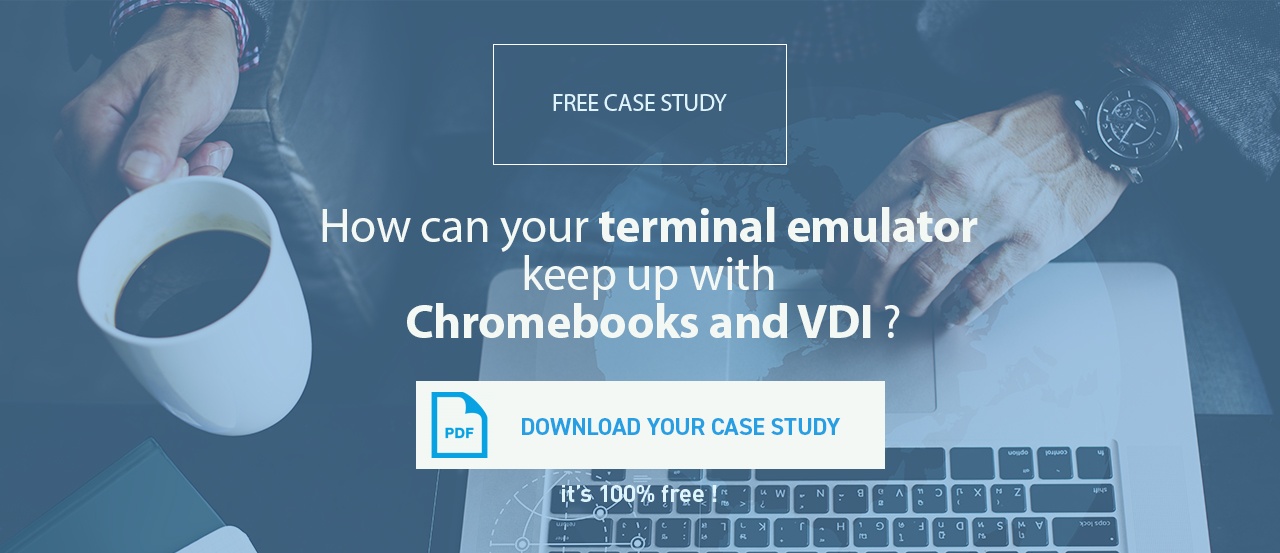Posted by Julien DUMEZ
January 18, 2021
Can your TN3270 emulator keep up with Chromebooks and VDI?

With the recent pandemic and boom of remote working, properly equipping employees has become a key concern for CIOs. Company computers are usually chosen thanks to a compromise between cost and performance.
And while computer manufacturers have offered durable and affordable products for a long time (shoutout to Lenovo and their iconic Thinkpads), managers have started to look for innovative solutions to cut down on hardware costs and simplify IT support. Of course, this also includes companies relying on legacy applications.
If we look at current trends of reducing the cost of equipping employees, we’ll find that Chromebooks and VDI are among the most notable. Let’s take a closer look at why these solutions are so attractive and how companies using IBM 3270 applications can also benefit from them.
Why are companies making the change to Chromebooks and VDI?

What is a Virtual Desktop Infrastructure?
VDI or Virtual Desktop Infrastructure is not a new technology by any means. Some may even remember its notable lag issues when it was first introduced. Indeed, network latency greatly affected virtual desktop performance during its first years.
However, VDI has improved a lot since then. To refresh your memory, VDI is an infrastructure that hosts desktop environments on a central server. These desktop images run within virtual machines that are controlled by a hypervisor and are available to end clients via a network.
What are the advantages of a Virtual Desktop Infrastructure?
It is clear that VDI’s main advantage is simplified remote access to the company's applications and data. Employees can input their login information from anywhere, and safely access their work files and applications. This is an ideal setup for workers who are often away from their workspace and companies who already deploy cloud or web-based solutions.
Although there is quite a debate on whether VDI is truly a cheaper alternative (because of server costs), there is no doubt that it lowers the cost of user hardware. Indeed, VDI often extends the lifespan of new PCs and can allow older PCS to run a more recent OS and updated applications.

What is a Chromebook?
At first glance, Chromebooks look like any other traditional laptop. However, as our mothers used to tell us, what matters is what is on the inside. And Chromebooks are defined by their insides, or OS to be more precise. Chrome OS is an operating system owned by Google and based on Linux. This operating system is focused on simplicity and will therefore boot up very quickly (in less than a second if you believe the commercials). Think about Chrome OS as being as simple and straightforward as the OS on your phone.
What is so great about Chromebooks?
Running such a simple OS allows Chromebooks to have lower specs which can drastically affect their price. Nowadays, you can find many Chromebooks under $300 that can run all the apps you need (especially the Google Suite). These computers were designed to work with a minimum amount of software installed.
As such, there is less software to update or support when using a Chromebook, which cuts the IT department’s work in half! Most applications on Chromebooks will be updated by Google and if users encounter problems, they can always contact help desks in real-time
Why are companies using IBM legacy applications having difficulties adopting Chromebooks or VDI?

VDI and Chromebooks are excellent cost-saving solutions to complement a company’s digitalization. Unfortunately, VDI and Chromebooks are difficult to organize around legacy applications. Let’s start with Chromebooks first.
As we have mentioned before, Chrome OS is a very simple operating system that streamlines the user experience. It works wonderfully with applications you can find on the Google Play store (however few there may be).
However, most traditional TN3270 emulators built on a heavy client infrastructure are not compatible with this OS. If they even were compatible, it would defeat the purpose of using Chromebooks (since they were meant to lighten the IT support’s workload).
And when it comes to installing a TN3270 emulator on a virtual desktop, it will most likely require colossal efforts from your IT team. Indeed, a common misconception about VDI is that all applications are easily virtualizable.
We have clients who have experienced this firsthand. They invested in a VDI solution thinking they would easily migrate their TN3270emulator. In the end, they had to hire additional experts which raised their overall deployment costs. Again, it seems counterintuitive to use up so many resources for a solution that was meant to cut costs.
How can you still use your IBM 3270 applications with VDI and Chromebooks?
The answer to the limitations of both VDI and Chromebook is the same: get the right type of TN3270 emulator. There are broadly three types of TN3270 emulators: heavy client, thin-client with a middle server, and finally 2-tier thin-client emulator.
The type of emulator we recommend for VDI is the last one. 2 tier thin-client TN3270 emulators are called that way because they only involve two elements, or tiers: the mainframe and a browser. The software itself is installed directly on the mainframe. It can then be accessed through any standard web browser (and its subsequent updates) through a URL.
This solves every compatibility problem you can encounter with VDI and Chromebooks because all you need to use a 2-tier web thin-client emulator is an internet connection and a standard web browser. 2-tier thin-client emulators are indifferent to operating systems and hardware specs, which makes them easy to deploy on any type of device or infrastructure.
2-tier thin-client terminal emulators were designed to accompany a company’s gradual digitalization. As such, their technology which mainly relies on web browsers works seamlessly with newer web and cloud-based technologies. Therefore, this emulator is a legitimate investment for companies readying themselves for future technological innovations
Legacy applications can often feel like a burden when companies implement massive changes in their IT infrastructures. However, with the right tools in hand (such as a 2-tier thin-client emulator), VDI and Chromebooks are no longer out of reach.
Topics: 3270 Emulation, Mainframe, z/OS





